The voltage can be regulated by the volt potentiometer on the AVR regulator or by an external control device, commonly used by the genset industry to govern the genset.
With our digital AVR regulator, it is possible to control and adjust the range of voltage, electrically through our compatibility software. With a wide variety of characteristics for different applications, we’re sure to have an Automatic Voltage Regulator for your business or project.
Below are some examples of the Mecc Alte Automatic Voltage Regulators available on our products. For more information on the features and characteristics of our Automatic Voltage Regulators, please don’t hesitate to get in touch.

DIGITAL AUTOMATIC VOLTAGE REGULATORS
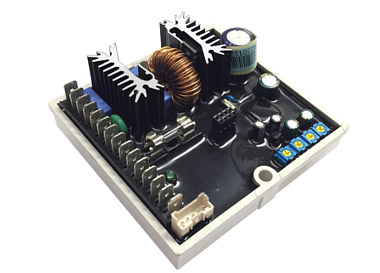
DSR
The DSR regulators are an advanced digital AVR regulator for generators replacing the traditional automatic voltage regulator. This voltage regulator is fully digital controlled and is fitted as standard across all our ECO and ECP models.
Connections on the DSR regulators are through 15 fast on / fast off connectors which speed up the connection process. This is especially useful if reconnecting a 12 wire machine to any specific voltage. This regulator is cross-compatible with all ECO and ECP machines and can be used as standard with the MAUX system and the PMG ma systems, so there’s never any need to change regulators. Its single phase sensing comes as standard.
By means of the external communication board (DXR or DL1), computer connection (RS232 or USB) or PLC connection (RS485 via MODBUS) is available. This allows changes to the digital AVR settings, to monitor in real-time performances (Voltage, Frequency or DSR status), or to download the alarm report (Communication software is available from Mecc Alte).
Characteristics
| Variable voltage supply | 40 ÷ 270 Vac |
| Frequency range | 15 Hz ÷ 72 Hz |
| Precision of voltage regulation | ± 1% |
| Maximum continuous output current | 5 Adc |
| Environmental temperature | -25°C ÷ +70°C |
| Regulation | True RMS or average measurement (70÷280 Vac) |
| Transient power drops and overvoltage | within ± 15% |
| Voltage recovery time | within ± 3% of the value set, in less than 300 msec |
| Transient overvoltage during start up | less than 5% of nominal voltage |
| Sensing | Single phase |
| Parameters (can be programmed via software) | VOLT, STAB, AMP and Hz can be set with trimmers (default) |
| 50/60Hz through a “jumper” (default) |
Features
| Analogical remote control of output voltage is possible through external voltage (0÷2,5Vdc) or with a 10 Kohm linear potentiometer |
| Underspeed protection with adjustable threshold and slope |
| Overvoltage and undervoltage alarms |
| Excitation overcurrent protection with delayed intervention |
| Management of temporary short circuits (start up of asynchronous motors) |
| Open collector output (not insulated) signalling intervention of protective devices (insulation on optional DI1 module) with programmable activation with respect to the individual alarms and the possibility to delay intervention |
| Abnormal operation conditions storage (type of alarm, number of events, duration of the last event, total time) |
| Memorization of the regulator operation time (starting from revision 11 of the Firmware) |
| USB communication interface (with an optional USB2DxR module) |
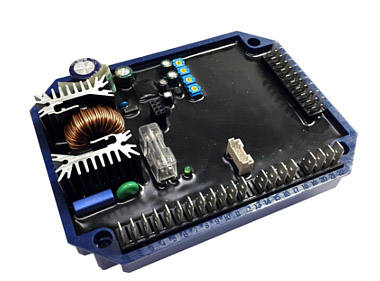
DER1
Born as a DSR evolution, it is building is extra feature such as single and three phases sensing automatic detection, higher flexibility in remote voltage control, soft start and a voltage precision of 0.5% in static condition.
The connectors for connection to and from the power generator and communications module are located on the DER1 regulator. The supervision unit can be made up of a personal computer, another “synoptic” device or both; it does not have the function of controlling the system in real time, but allows programming and visualisation of all operational parameters of the DER1.
Since the regulator is designed to control many different types of generators, it must be appropriately configured to obtain the best performance; most of the settings are stored in a non-volatile integrated memory (EEPROM)
Characteristics
| Variable voltage supply | 40 ÷ 270 Vac |
| Frequency range | 12 Hz ÷ 72 Hz |
| Precision of voltage regulation | ± 1% |
| Precision of voltage regulation (stabilized condition) | ± 0,5% |
| Maximum continuous output current | 5 Adc |
| Environmental temperature | -25°C ÷ +70°C |
| Voltage regulation | 75÷300 Vac |
| Transient voltage drop and overvoltage | within ± 15% |
| Voltage recovery time | within ± 3% of the value set, in less than 300 msec |
| Sensing | Single phase or Three phase |
| Parameters (can be programmed via software) | VOLT, STAB, AMP and Hz can be set with trimmers (default) |
| 50/60Hz through a “jumper” (default) |
Features
| Power connections through 20 poles Fast-On connector |
| Protection of power winding with 5A fast acting fuse |
| 0 ÷ 2,5Vdc or -10 ÷ +10Vdc external voltage for analogical remote control of output voltage |
| Remote control of output voltage through external potentiometer (from 25Kohm to 100Kohm) |
| Underspeed protection with adjustable threshold and slope |
| Overvoltage and undervoltage alarms |
| Excitation overcurrent protection with delayed intervention |
| Underexcitation alarm/loss os excitation |
| Management of temporary short circuits (start up of asynchronous motors) |
| Open collector output (not insulated) signalling some allarm intervention with programmable activation in respect of each alarm and possibility of the intervention delay and selectable active level |
| Allarm conditions storage (type of alarm, number of events, duration of the last event, total time) |
| Memorization of the regulator operation time |
| USB communications interface (with optional USB2DxR module) |
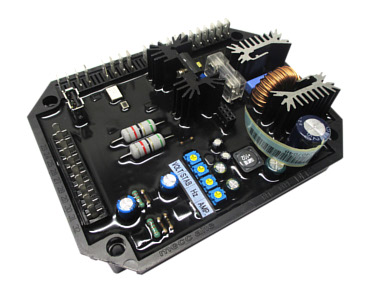
DER2
The DER2 is a digital automatic voltage regulator for synchronous alternators, designed for stand alone working and calibration; the connectors for connection to and from the power generator and to the supervision unit are located on the DER2 regulator.
DER2 includes natively the USB port for computer remote monitoring and control and the HDR module.
The High Dynamic Response allows a faster reduction of excitation current than conventional regulators and consequently a smaller transient overvoltage as a result of load removal.
The supervision unit can be made up of a personal computer, another “synoptic” device or both; it does not have the function of controlling the system in real time, but allows programming and visualisation of all operational parameters of the DER2 through the embedded USB port
Characteristics
| Variable voltage supply | 40 ÷ 270 Vac |
| Frequency range | 12 Hz ÷ 72 Hz |
| Precision of voltage regulation | ± 1% |
| Precision of voltage regulation (stabilized condition) | ± 0,5% |
| Maximum continuous output current | 5 Adc |
| Environmental temperature | -25°C ÷ +70°C |
| Voltage regulation | 75÷300 Vac |
| Transient voltage drop and overvoltage | within ± 15% |
| Voltage recovery time | within ± 3% of the value set, in less than 300 msec |
| Sensing | Single phase or Three phase |
| Parameters (can be programmed via software) | VOLT, STAB, AMP and Hz can be set with trimmers (default) |
| 50/60Hz through a “jumper” (default) |
Features
| Power connections through 20 poles Fast-On connector |
| Protection of power winding with 5A fast acting fuse |
| 0 ÷ 2,5Vdc or -10 ÷ +10Vdc external voltage for analogical remote control of output voltage |
| Remote control of output voltage through external potentiometer (from 25Kohm to 100Kohm) |
| Underspeed protection with adjustable threshold and slope |
| Overvoltage and undervoltage alarms |
| Excitation overcurrent protection with delayed intervention |
| Underexcitation alarm/loss os excitation |
| Management of temporary short circuits (start up of asynchronous motors) |
| High Dynamic Response: load removal management unit |
| Open collector output (not insulated) signalling some allarm intervention with programmable activation in respect of each alarm and possibility of the intervention delay and selectable active level |
| Allarm conditions storage (type of alarm, number of events, duration of the last event, total time) |
| Memorization of the regulator operation time |
| USB communications through the embedded USB port |
DIGITAL EXCITATION CONTROL SYSTEM
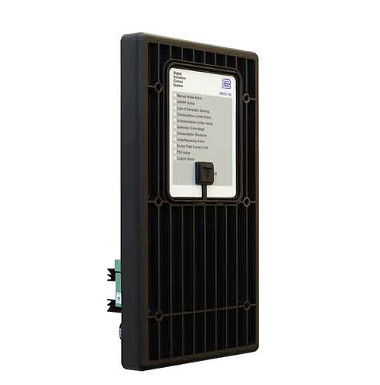
DECS-150
DECS-150 Digital Generator Excitation Control Systems offer precise excitation control and machine protection in a compact package. DECS-150 adaptability to many applications is assured through configurable contact inputs and outputs, flexible communication capabilities, and programmable logic implemented with the provided software. The high flexibility and powerful functionalities makes this device particularly useful in those projects where machines are paralleled to other generators and/or the utility system, since the requirements from the grid codes are very demanding.
The DECS-150 is suitable for the Mecc Alte brushless alternators starting from ECO38 to ECO46, including the medium and high voltage series ECO46 and ECO49. In fact, the DECS-150 can be fed indifferently by the PMG3, MAUX or even shunt-excited.
Excitation power is supplied from the DECS-150 by means of a filtered, switching power module that uses pulse-width modulation. It is capable of supplying 7 Amps at 70°C ambient temperature and has a forcing capability of 11 Amps for 10 seconds.
Characteristics
| DC Operating Power | |
| Full Load Continuous Current | 10 A at 55°C 7 A at 70°C |
| AC Operating Power | |
| Power Input Configuration | 1-phase 3-phase |
| Power Input Frequency | dc, 50 to 500 Hz |
| Nominal Input Voltage | 120 ÷ 240 Vac 250 Vdc |
| Generator and Bus Voltage Sensing | |
| Configuration | 1-phase 3-phase–3-wire |
| 50 Hz Voltage Ranges | 100 Vac ±10% 200 Vac ±10% 400 Vac ±10% |
| 60 Hz Voltage Ranges | 120 Vac ±10% 240 Vac ±10% 480 Vac ±10% 600 Vac ±10% |
| Frequency | 50/60 Hz nominal |
| Burden | <1 VA per phase |
| Generator Current Sensing | |
| Configuration | 1-phase or 3-phase with separate input for cross-current compensation |
| Nominal Current | 1 Aac |
| Frequency | 50/60 Hz |
| Burden | <0,1 VA |
| Environmental | |
| Operating Temperature (10 A Continuous) | –40°C to 55°C |
| Operating Temperature (7 A Continuous) | –40°C to 70°C |
| Storage Temperature | –40°C to 85°C |
| Communication | |
| USB | USB type B port |
| Ethernet | RJ45 jack 10BASE-T 100BASE-TX |
Features
| Voltage regulation accuracy ±0,25% |
| THD-tolerant design offers reliable operation with nonlinear loads |
| True RMS three-phase generator voltage sensing/regulation |
Four excitation control modes:
|
| Auto tuning feature |
| Soft start and voltage buildup control |
| Integrated droop and cross current compensation |
| Diodes failure detection |
| Remote setpoint control input accepts analog voltage or current control signal |
| Real-time metering |
Wide range of limiting and protection functions:
|
| Eight programmable contact-sensing inputs |
| Three contact outputs |
| Flexible communication: Serial communication through USB port and Ethernet communication |
| Data logging and sequence of events |
| USB powered for programming via BESTCOMSPlus software |
ANALOGIC AUTOMATIC VOLTAGE REGULATORS
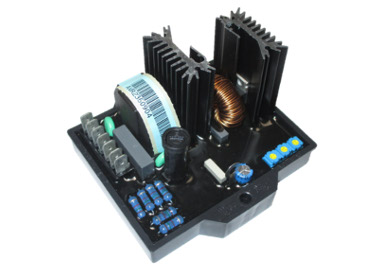
ASR
The Latest-technology ASR (Analogic Simplified Regulator) assures a trouble-less use, a precise voltage control and an underfrequency protection.
The ASR is a closed loop AVR regulator system, that controls and keeps constant the alternator output voltage. The output voltage of the alternator is monitored and confronted with a reference signal: the difference between the two is used to control the conduction state of an SCR.
The SCR is controlled by the width of its pulse, and resulting in a rectified DC output which is injected in the rotating inductor of the generator, generating consequently the AC output voltage.
This regulator is specific for ES and ET series.
Characteristics
| Input power supply | 180 ÷ 280 Vac |
| Precision of voltage regulation | ± 2,5% |
| Maximum output current | 6 A |
| Working temperature | -20°C ÷ +70°C |
| Standard generator voltage regulation | 100 ÷ 280 Vac |
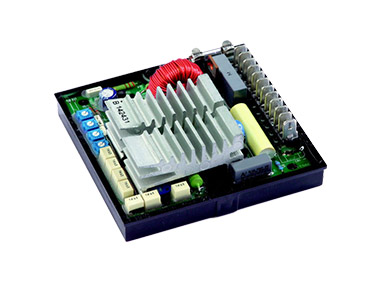
S.R.7/2-G
The S.R.7/2-G regulator is an advanced electronic AVR voltage regulator of small size and economical price, even if it is very reliable.
This regulator is equipped with a low speed and overload protection with an adjustable intervention threshold, it works at 50/60 Hz, it has an adjustable voltage stability and it offers the possibility for a remote voltage regulation.
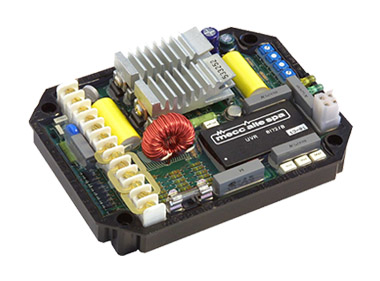
U.V.R.6/1-F
The U.V.R.6/1-F is built with the same technology as the S.R.7/2-G and aside from having the same performances and characteristics it also includes the possibility of three-phase as well as singlephase sensing (we suggest to choose this option in case of very unbalanced or non-linear loads) and LED's of self-diagnosis which indicate the machine operating conditions instant by instant.
Hereafter with the wording UVR6 we mean all the regulators suitable for being used at 50Hz and 60Hz, both threephase and singlephase, with the wording UVR6-H400 we mean all the regulators suitable for being used at 400Hz. The components of these regulators are modern, utilising solid-state integrated circuit technology. These components were chosen to guarantee maximum durability and reliability. The entire unit, also made using a hybrid circuit, is inside a box of modest dimensions that has been impregnated with resin to protect against vibrations and ingress of water.







